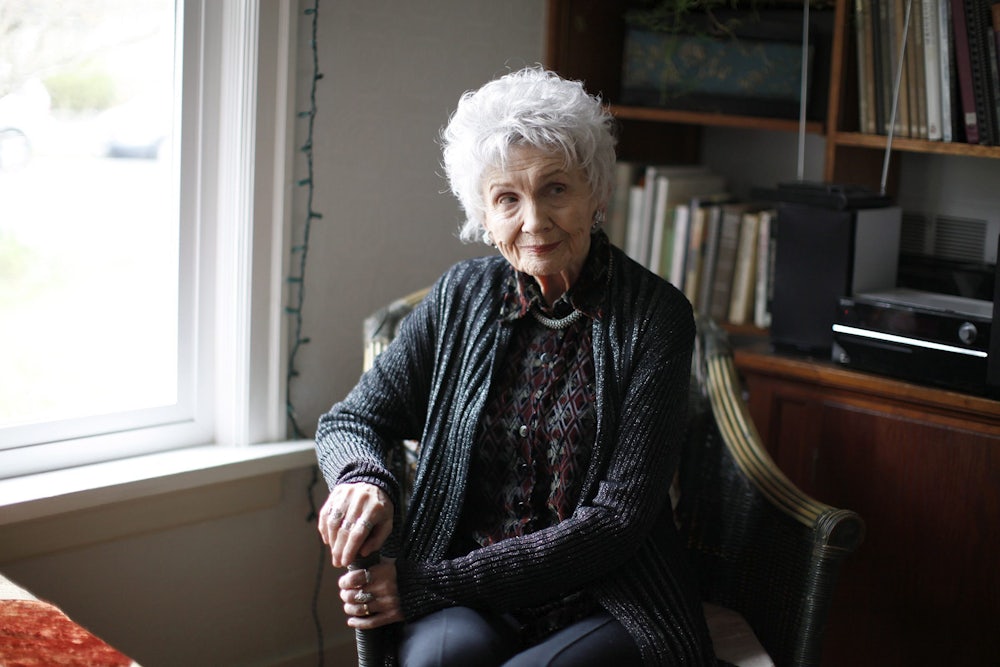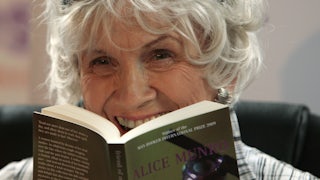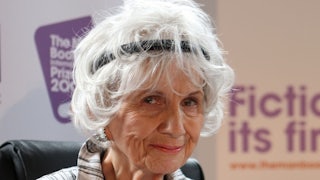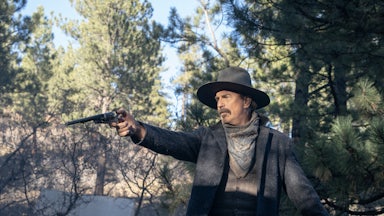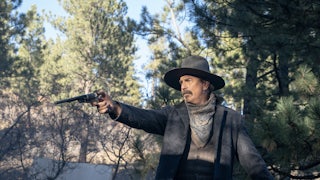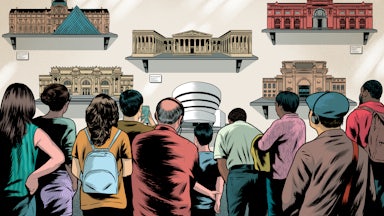Just over a decade ago, when James Wood wrote about four memoirs by the children of writers, I wondered why he’d left out Sheila Munro’s Lives of Mothers & Daughters: Growing Up With Alice Munro (2001). True, Wood’s essay, “Sins of the Father,” was about Cheever, Malamud, Styron, Bellow, and patriarchy in postwar America. But even a passing mention of Munro, I thought at the time, might have served to remind us that “the storm of assertion”—Wood’s phrase for the self-justification that often goes with writing—need not always clear “a brutal path” through a writer’s family. The portrait of Alice Munro by her eldest child, Sheila, was loving, and I believed it.
I also believed that Munro’s life was split in two: “After the turbulence and dislocation she went through before Ms. Munro turned 40,” as the New York Times obituary noted, “her life and career clicked satisfyingly into place when she returned to southern Ontario.” Before 40: an increasingly ill mother, an increasingly unhappy first marriage, the struggle to write and publish while caring for three daughters (another died soon after birth). Munro worked—“Housewife Finds Time to Write Short Stories,” as the first profile of her notoriously had it—careful to hide what she was doing from other suburban mothers; but she also failed to work, developed an ulcer, and at one point suffered from an anxiety disorder in which she feared she’d stop breathing. When she won Canada’s Governor General’s Award for her first book, it “did a lot,” she recalled later, “for my prestige in the family.”
And the rest of her life? Divorced from Jim Munro, she moved in with Gerald Fremlin, whom she’d seen, Sheila tells us, as “a dark, lean Byronic figure” when they’d met decades earlier at university. He was smitten at the time only with her stories, which even then reminded him of Chekhov’s. In 1977 she was granted a first-reading agreement with The New Yorker; in the next decades she won so many awards that she began taking herself out of the running for them. Though beset as always by compositional challenges—the writerly difficulties that don’t and shouldn’t go away—she was steadily productive. Reviewing 2009’s Too Much Happiness, Michael Gorra noted that Munro’s work had been translated into 13 languages: “That’s not enough, but one of them is Swedish.” In 2013 came the Nobel.
Now, thanks to articles by and about Andrea Robin Skinner, Munro’s youngest daughter, we have not only a full picture of the sins of this particular mother—Munro effectively chose Fremlin, who abused Andrea when she was a child, over Andrea—but a revised understanding of her split life. The problems in the first marriage were fairly commonplace, as were the frustrations of her apprenticeship and early career. There are no obvious villains in this period. The years with Fremlin, on the other hand, whom Munro does appear to have loved, seem a horror: When Andrea came forward, Fremlin wrote appalling letters of self-defense and made threats to kill Andrea and himself. And though after his death in 2013 Munro changed her plans to be buried next to him, in life she stuck with him, telling protective lies about him to journalists and the police, and allowing secrecy and silence to swirl in the family and well beyond it.
The smooth literary productivity looks different too, along with what was said about it at the time: “Such first-rate abundance is an astonishment in any lifetime, let alone that of a middle-class mother, and is—to rework Faulkner’s quip regarding Keats—worth any number of young daughters,” Lorrie Moore wrote in her review of the 2004 collection Runaway. “Though, of course, for the writer it is always more complicated than that. For the reader, however, it is a lovely and simple matter of greed and joy.”
For some readers, though, there was uneasiness even back then. Reviewing Too Much Happiness in these pages, Ruth Franklin identified “a problem with Munro’s portrait of the human world.” Noting the abundance of male characters “who range from mediocre to truly monstrous,” Franklin asked: How do they “exercise such power over the women in their lives? And why do the women—each of them strong, distinguished, unconventional—allow them to do it?” Too few critics were considering these questions, I thought. In Munro’s early work many of the unloved or abandoned men are actually quite impressive. About later Munro, Franklin is correct: controlling males, abusers, even murderers.
There is also a more pronounced difference between the early and late work. Al Alvarez once noted that the young women in Runaway are “doomed to disappointment because of the places they come from—they are doomed, that is, by their intelligence to live three-dimensional lives in two-dimensional worlds.” Indeed they are, but by this point the thwarted or stifled extraordinary woman is no longer Munro’s chief preoccupation. In the 1990s and early 2000s (after Andrea’s revelations) and after 2005 (when Fremlin was arrested and pleaded guilty), the stories are almost unrelievedly dark.
This was not a controversial assessment—not even with Munro herself. “I think they are [darker],” Munro agreed in 2004 when the CBC’s Eleanor Wachtel rattled off a list of disturbing subjects in Runaway. “As you become older, maybe there are more things like this sort of coming closer to your life. Things you know about.” Reading the stories as they appeared and then in collections, I sometimes found them rather top-heavy with violence and transgression. “Such things happen,” as Munro wrote in her story “Save the Reaper.” “But not as regularly as on television or in the movies.”
Among the things that happen just in Too Much Happiness: A boy murders his family and then, posing as a utility inspector, gains entry to the home of a widow dying of cancer; she obliquely talks him out of killing her (“Free Radicals”). A father murders his three children (“Dimensions”). An elderly man, Mr. Purvis, uncertainly but creepily involved with a much younger woman, makes her university roommate dine with and read to him naked: “And may I ask you please—may I ask you please—not to cross your legs?” he says. She complies (“Wenlock Edge”). Two girls at summer camp drown a third, a child with special needs. They are not found out; the drowning is thought to be an accident (“Child’s Play,” a story with which I had an especially hard time).
But if the number of harrowing incidents in late Munro struck me as implausible, the characters’ reactions did and do not. The poem that the university student read to Mr. Purvis, she realizes, will always remind her of what she had agreed to do: “Not been forced, not ordered, not even persuaded. Agreed to do.” The campers grow up and appear to conduct their lives as if nothing has happened: One becomes a housewife who, though “sadly” childless, as she reports in a letter to her friend, is contentedly busy with volunteering and hobbies; the other is a distinguished scholar. How can they be so blithe? They are not. When one of the women is terminally ill with cancer, she sends for the other. In a shakily written letter handed over by a nurse—the woman is by now unconscious—she begs her friend for the help of a priest. “This I cannot ask C”—her husband—“and do not want him ever to know … Marlene please do this bless you.” We are shown what secrecy has done to both women.
In “Dimensions,” Lloyd, the murderer who has been sent to a facility for the criminally insane, reports to Doree, the mother of the three dead children, that he has had visions of the kids, who are well—“really happy and smart.” This brings her unexpected, immense comfort: “In all the time since what had happened, any thought of the children had been something she had to get rid of, pull out immediately like a knife in her throat.… What was different now was that she had a refuge she could go to.” It wasn’t her social worker, Mrs. Sands, who had given it to her, but her husband—“that terrible person, that isolated and insane person.” Yet there’s more: She believes that perhaps Lloyd, “of all people, might be the person she should be with now.” She means, of course, by continuing to visit him. Her reaction to this discovery is worth quoting in full:
What other use could she be in the world—she seemed to be saying this to somebody, probably to Mrs. Sands—what was she here for if not at least to listen to him?
I didn’t say “forgive,” she said to Mrs. Sands in her head. I would never say that. I would never do it.
But think. Aren’t I just as cut off by what happened as he is? Nobody who knew about it would want me around. All I can do is remind people of what nobody can stand to be reminded of.
If you find unbearable what this woman tells herself, know that Doree, for reasons I need not reveal, changes her mind while on her next bus ride to visit Lloyd.
Other stories, equally convincing, are less consoling. In the title story of Runaway, a young woman is helped by an older neighbor to leave her emotionally abusive husband. She has been provided with money and a place to stay; logistically, the getaway is possible. Emotionally, she falters, and demands that a bus driver pull over and let her off. She fears not just the unknown but a world in which, without her husband, she would in some sense cease to exist. In “Floating Bridge,” a story from 2001’s Hateship, Friendship, Courtship, Loveship, Marriage, we learn that the protagonist, Jinny, has tried and failed for much the same reason to leave her emotionally abusive partner, who, as it happens, has a tendency to become giddy and mushy over some of the boys and girls he’s met while working at a correctional institute for “Young Offenders.”
In an essay about Hemingway, Joan Didion complains that “the increasing inability of many readers to construe fiction as anything other than roman à clef, or the raw material of biography, is both indulged and encouraged.” In Munro’s case, one can avoid the temptation to map specific real events onto specific stories and still see through the late collections an abiding preoccupation with guilt and secrets and failures of resolve—not just in “Vandals,” so closely analyzed in recent weeks, or “Silence,” but also in stories with no clear autobiographical currents.
Yet it’s worth remembering that Munro also knew things, as a character of hers puts it, “as an artist knows them. Not necessarily by experience.” The passage in Munro that has most astonished me in the wake of Andrea Skinner’s revelations was written before Gerald Fremlin came back into her life, before she was 40. In Lives of Girls and Women (1971), Del Jordan’s first lover, whom Del has met at a revival meeting, attempts to baptize her in the river. He bobs her in the water “with less and less gentleness”; she refuses to go along; they struggle. After he pushes her down unexpectedly and she comes up gasping, that’s that for this romance. Reflecting on their end, Del thinks,
If we had been older we would certainly have hung on, haggled over the price of reconciliation, explained and justified and perhaps forgiven, and carried this into the future with us, but as it was we were close enough to childhood to believe in the absolute seriousness and finality of some fights, unforgivability of some blows. We had seen in each other what we could not bear, and we had no idea that people do see that, and go on, and hate and fight and try to kill each other, various ways, then love some more.
It’s as if Munro saw exactly what was coming, though I suspect she would have shuddered, just as we do, at the particulars of her own unforgivability.
